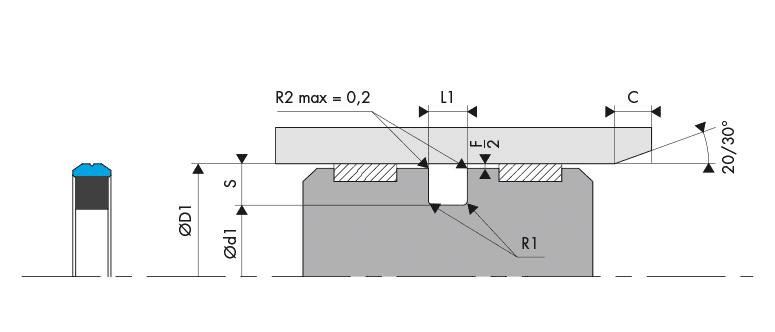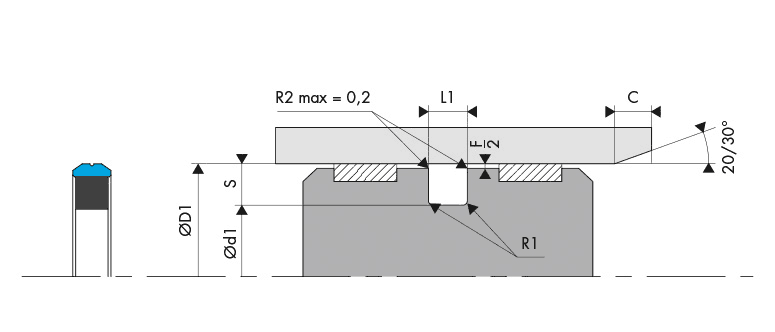BECA 519



Description
The BECA 519 profile is a double acting composite piston seal composed of a polyurethane friction ring and a profiled rubber ring.
Advantages
Good sealing in static and dynamic applications
The square ring does not twist under pressure
Suitable for reduced axial size
Technical data
| Temperature | -30°C/+100°C |
|---|---|
| Pressure | 40 MPa |
| Speed | 0.5 m/s |
| Medias | Mineral hydraulic oils |
Applications
Mobile machinery
Injection presses
Hydraulic cylinders
Materials
Profiled seal
NBR 70 Shore A if ØD1 ≤ 63.00 mm
NBR 80 Shore A if Ø D1 > 63.00 mm
Friction ring
PU 93 Shore A - Blue
PU 96 Shore A - Blue
High temp. PU 96 Shore A - Beige
TPC-E (Hytrel)
Dimensions

Materials
PU
Polyurethane is a material that has the elastic properties of rubber. The proportion in its composition (diisocyanate, polyol, chain extender) is determined by its properties. This material is characterised by a strong mechanical resistance, good wear resistance, high elastic modulus, good flexibility and a very good ozone and oxidation resistance.
| Chemical resistance | Pure aliphatic hydrocarbons (propane, butane) Mineral oils and greases Silicone oils and greases Water up to +50°C |
|---|---|
| Compatibility issue | Ketones, esters, ethers, alcohols and glycols Hot water, steam, alkalis, amines and acids |
| Temperature range | -30°C/+90°C -30°C / +110°C with our PUHT (short term peak at 150°C) |
NBR
Nitrile rubber (NBR) is the general term for acrylonitrile-butadiene copolymer. The ACN content can vary between 18% and 50%. While the acrylonitrile content is important, the resistance to oil and fuel is more so. Conversely, the elasticity and compression set are not as good. The NBR has good mechanical properties and good wear resistance. However, its resistance to atmospheric agents and the ozone is relatively low.
| Chemical resistance | Aliphatic hydrocarbons (propane, butane, petroleum, diesel fuel) Mineral oils and greases Fire-resistant fluids (HFA, HFB and HFC) Diluted acids, low-temperature alkaline and saline solutions Water (up to +100°C max) |
|---|---|
| Compatibility issue | Fuels with high aromatic content Aromatic hydrocarbons (benzene) Chlorinated hydrocarbons (trichlorethylene) Polar solvents (ketone, acetone, acetic acid, ethylene-ester) Strong acids Glycol-based brake fluids Atmospheric and ozone agents |
| Temperature range | -30°C/+100°C -40°C / +100°C with our low-temperature NBR |
Technical data

Extrusion gaps
| Radial section S |
Radial extrusion gap F/2 |
|||
|---|---|---|---|---|
| 10 MPa | 25 MPa | 35 MPa | 40 MPa | |
| 3.75 | 0.30 | 0.20 | --- | --- |
| 5.50 | 0.40 | 0.30 | 0.20 | --- |
| 7.75 | 0.50 | 0.40 | 0.30 | 0.25 |
| 10.50 | 0.60 | 0.50 | 0.40 | 0.35 |
| 12.50 | 0.65 | 0.55 | 0.45 | 0.40 |
Surface roughness
| Roughness | Dynamic surface area | Static surface area | Groove flanks |
|---|---|---|---|
| Ra | 0.1 - 0.4 µm | ≤ 1.6 µm | ≤ 3.2 µm |
| Rz | 0.63 - 2.5 µm | ≤ 6.3 µm | ≤ 10.0 µm |
| Rmax | 1.0 - 4.0 µm | ≤ 10.0 µm | ≤ 16.0 µm |
Chamfers and radius
| Radial section S |
Radius R1 | Chamfer C |
|---|---|---|
| 3.75 | 0.20 | 2.00 |
| 5.50 | 0.30 | 2.50 |
| 7.75 | 0.30 | 3.00 |
| 10.50 | 0.40 | 5.00 |
| 12.50 | 0.40 | 9.00 |
Only on request
